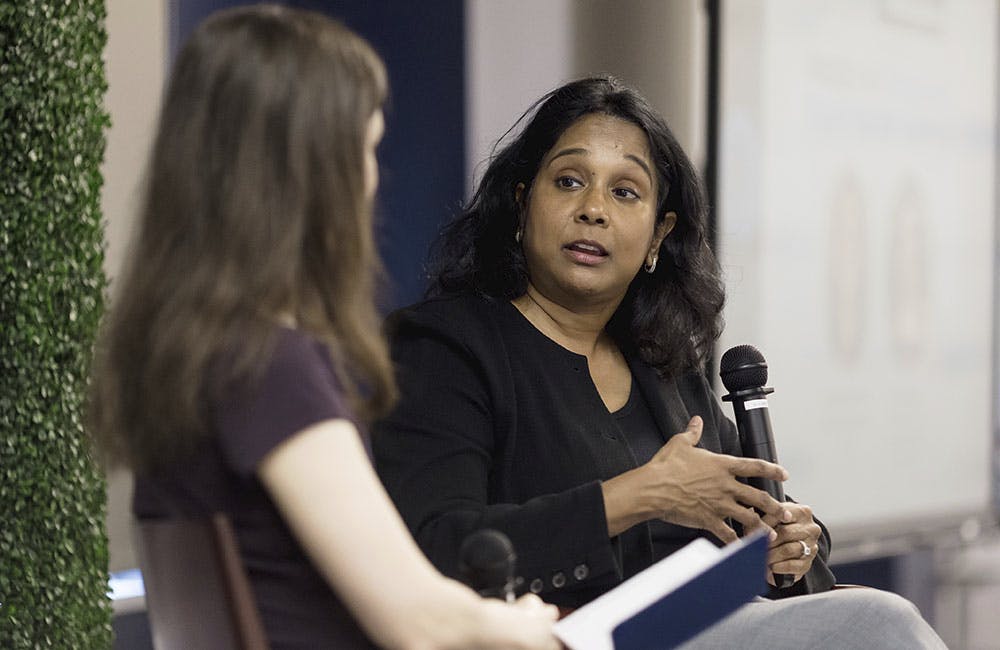DOD AI Deputy: AI is an ‘Enabler’ of Mission Areas
Pentagon Chief Digital and AI Office’s Margaret Palmieri said AI is part of nearly everything DOD does to enhance mission and warfighting.

The Defense Department is expanding efforts to use artificial intelligence as a tool augmenting the human workforce to enhance nearly all mission and warfighter efficacy, the deputy AI official at the Pentagon said last week.
“AI is kind of like electricity. It’s not a specific thing. It’s an enabler of a bunch of different mission areas,” said Pentagon Deputy Chief Digital AI Officer Margaret Palmieri at the 2024 Billington Cybersecurity Summit.
Her office has been building the foundations of “AI electricity” by focusing efforts on hiring the best talent, finding the right compute and getting access to learning models in order to maintain a competitive advantage.
“How do we look through our current portfolio, pull across the capabilities that may be in the research and development phase now, but have to get into the hands of operators, have to be tested and evaluated and trained, and make sure that we’ve got good pipelines to do that?” Palmieri said. “We usually can’t predict the next crisis and we don’t really know what the exact need may be in the future.”
According to Palmieri, the department has over 1,000 AI applications using approximately $1.5 billion across the department.
Palmieri added that DOD is adhering to ethical AI principles and working across the national security ecosystem to coordinate AI compliance.
“What we in CDAO look for is, how do we enable those AI projects that are really integrated into mission areas across DOD, whether it’s on the business side or whether it’s on warfighting side,” said Palmieri. “How do we make sure that they’re done responsibly?”
She cited a governance meeting where her office “work[ed] with all the services and the different departments in DOD to talk about where everybody is on their efforts.”
“We were the first military [in the world] to sign ethical principles for the use of AI in 2020. We have a very robust, responsible AI toolkit and implementation pathway,” Palmieri said. “We take this very seriously and think about how you deploy these capabilities in a responsible way.”
The CDAO is also emphasizing what Palmieri described as AI scaffolding. DOD is investing in, she said, testing, evaluation, providing guidelines and data labeling and sharing, as to reduce barriers to AI adoption throughout the department.
Part of that is reducing friction in working with industry on department tech priorities. Palmieri said DOD has an acquisition “hierarchy of needs,” with AI at the top, analytics and metrics in the middle, and quality data at the bottom.
Working with industry through initiatives like the Small Business Innovations Research path, Tradewinds acquisition platform and Open Data and Applications Government-owned Interoperable Repositories, Palmieri said CDAO is examining how to implement technology like generative AI into DOD operations while maintaining security and resiliency.
“We want to leverage industry’s best, but we enforce technical architectures through contract language sometimes, and this is where we are. We’re going to buy the data platform separate from the applications. We’re going to make sure that data platform is open and that that data is available to all the providers that we need it to be, so that we can really start to unleash innovation at local levels and do that in a more effective way,” Palmieri said.
This is a carousel with manually rotating slides. Use Next and Previous buttons to navigate or jump to a slide with the slide dots
-

Inside Oak Ridge National Lab’s Pioneer Approach to AI
Energy Department’s Oak Ridge National Lab transforms AI vulnerabilities into strategic opportunities for national defense.
22m listen -

A Look at Federal Zero Trust Transformation
Recent developments from CISA and DOD show how government is advancing zero trust quickly.
20m read -

Modernization Strategies to Enable Energy Innovation
Lawrence Berkeley National Lab and Maximus experts explore the modernization strategies driving digital transformation and operational resilience within the energy sector.
33m watch -

DOI Must Modernize Energy to Win AI Race, Secretary Says
Doug Burgum links AI innovation to energy reform as DOI advances digital infrastructure and wildfire response under Trump’s tech agenda.
2m read -

NIST to Release New AI Cybersecurity Guidance as Federal Use Expands
NIST plans to release AI cybersecurity guidance within the year to support safe adoption as federal agencies expand use cases.
4m read -

Federal Zero Trust Forum
The Federal Zero Trust Forum brings together key technology leaders from across government to explore practical strategies and share lessons for advancing zero trust architecture.
Ritz Pentagon City | 1250 S Hayes St, Arlington, VA 22202 -

CIA Adds Fourth Pillar to AI Strategy, CAIO Says
Lakshmi Raman says the new pillar marks a strategic shift toward embedding AI more deeply into the CIA’s day-to-day mission execution.
3m read -

FEHRM CTO Targets Two-Year Cloud Migration for Federal EHR
Lance Scott touts new EHR tech advancements, including cloud migration, expanded data exchange and AI integration to improve care delivery.
4m read -

AI Enables Coast Guard’s Workforce to Transform Operations
The Coast Guard’s Deputy CIO Brian Campo delves into the ways AI is pushing the service to rethink its core services, workforce and operations.
14m watch -

DOL Turns to Workforce Development to Maintain AI Superiority
DOL is bridging the AI skills gap through partnerships and upskilling to ensure future AI workforce readiness.
10m watch -

Trump’s Executive Order Spurs Federal Push for AI Literacy
Agencies are ramping up AI literacy efforts across the federal workforce and education systems after Trump's executive order on AI education.
5m read -

AWS Summit: A DOE National Lab Uses GenAI to Boost Efficiency
Lawrence Livermore National Lab launches a new generative AI tool to drive operational efficiency at the National Ignition Facility.
9m listen
















